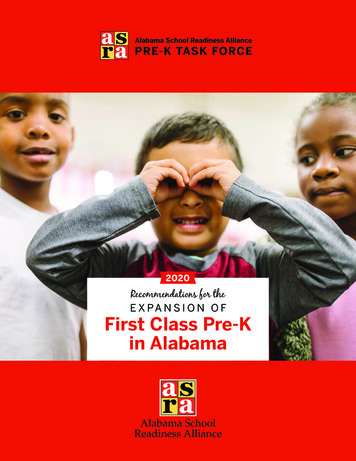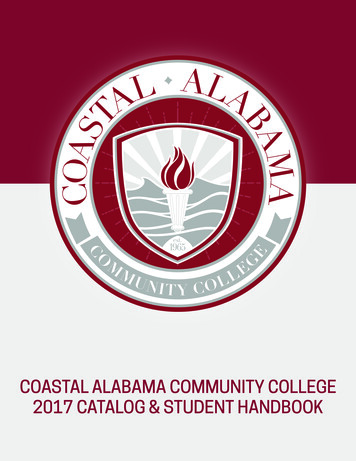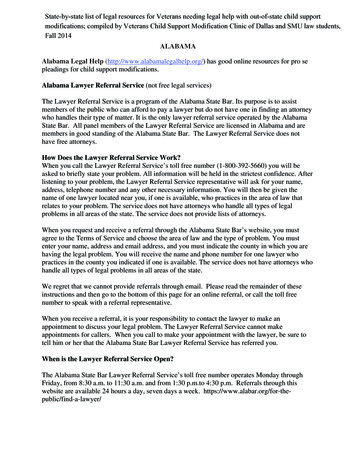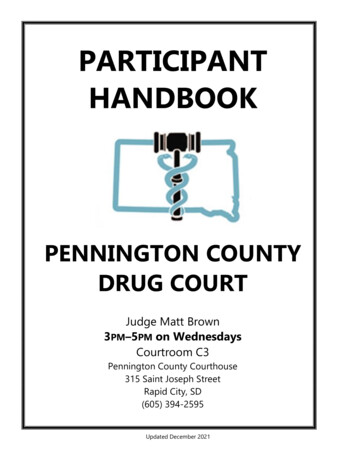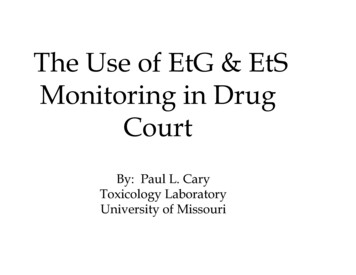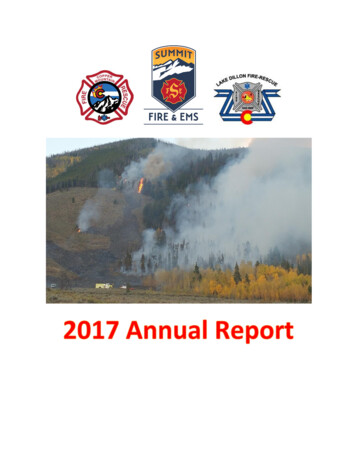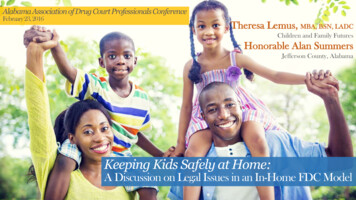
Transcription
Alabama Association of Drug Court Professionals ConferenceFebruary 23, 2016Theresa Lemus, MBA, BSN, LADCChildren and Family FuturesHonorable Alan SummersJefferson County, AlabamaKeeping Kids Safely at Home:A Discussion on Legal Issues in an In-Home FDC Model
AcknowledgementThis presentation is supported by:The Office of Juvenile Justice and Delinquency PreventionOffice of Justice Programs(2013-DC-BX-K002)Points of view or opinions expressed in this presentation are those ofthe presenter(s) and do not necessarily represent the official positionor policies of OJJDP or the U.S. Department of Justice.
Learning Objectives Explore the in-home FDC Model and the uniquefeatures and practice challenges within this model Discuss opportunities and challenges associated withchildren remaining in-home while participating inFDC Explores the lessons and experiences of an FDC site(Birmingham, AL) in addressing obstacles associatedwith the implementation of an In-Home FDCModel, and review specific evidence basedinterventions such as Safe Care
Keeping Kids Safely at Home:A Look at the In-Home FDC Model
PARENTAL AOD AS REASON FOR REMOVAL IN THEUNITED STATES 2.72005200614.515.3200720088.20 National Data2003 Alabama Data2004200920102011Source: AFCARS Data Files
PERCENT AND NUMBER OF CHILDREN WITH TERMINATEDPARENTAL RIGHTS BY REASON FOR REMOVAL, 2013Neglect (n 78,033)37.5%32.1%Parent Alcohol or Drug Abuse (n 44,153)AL Parent Alcohol or Drug Abuse (n 7,450)Parent Unable to Cope (n 24,775)Physical Abuse (n 19,072)Inadequate Housing (n 17,443)Parent Incarceration (n 8,424)Abandonment (n 7,200)Child Behavior (n 6,901)Sexual Abuse (n 5,967)Child Disability (n 5,031)Child Alcohol or Drug Abuse (n 3,320)Relinquishment (n 1,863)Parent Death (n e: AFCARS Data,2013
10.0%AL (N 8,697)AK (N 2,484)AZ (N 13,885)AR (N 8,971)CACOCTDE (N 1,482)DCFLGA (N 22,163)HI (N 1,331)IDILIN (N 23,359)IAKSKY (N 20,833)LAME (N 3,283)MD (N 15,762))MAMI (N 30,705)MN (N 4,143)MS (N 8,435)MO (N 5,322)MT (N 1,191)NE (N 3,940)NVNH (N 642)NJ (N 11,842)NM (N 7,606))NYNCND (N 1,616)OH (N 24,931)OK (N 13,183)ORPARI (N 3,410)SCSD (N 886)TN (N 11,695)TX (N 65,334)UT (N 9,876)VTVAWA (N 7,341)WV (N 4,962)WI (N 4,642)WY (N 861)PR (N 7,683)Percentage of child removalsCHILDREN WITH DRUG ABUSE CAREGIVER RISK FACTOR, 201470.0%60.0%50.0%40.0%30.0%20.0%5.5%0.0%5Source: Child Maltreatment, 2014
NUMBER OF CHILDREN IN OUT-OF-HOME CARE, 2002-2014600,000550,000NUMBER OF 200320042005200620072008200920102014
64% of child maltreatment victims remain at home84%Source: Children and Family Futures, in publicationAnother 20% return home
1994200220042007Next2014FDC MovementInstitutionalization &SustainabilitySystems Change InitiativesPractice Improvements – Children Services,Trauma, EBPGrant Funding – RPG, OJJDP, SAMHSASix Common IngredientsFirst Family Drug Courts emergedTowards Systems Change
How Collaborative Policy and Practice Impacts5RsRecoveryRemain at homeReunificationRecidivismRe-entry
440Median Length of Stay (days) inOut-of-Home CareDays in Foster Care422420400380360356340320RPG FDCRPG Comparison12
Percentage of Reunification within 12 monthsReunification Rates within 12 Months8073.1%7054.4%6050403020100RPG FDCRPG Comparison
Remained in HomePercentage of Children Who Remain at HomeThroughout Program CAMRPG FDCRPG Comparison
Recurrence of Child Maltreatment76Percentage of Children Who HadSubstantiated/Indicated Maltreatment withinSix Months54.9%3.4%435.8%2.5%210CAM ChildrenRPG Children - FDCRPG Children - No FDCRPG - 25 State ContextualSubgroup
Re-entries into Foster Care141213.1%Percentage of Children Re-entered intoFoster Care Within Twelve Months10864.6%5.1%CAM ChildrenRPG - Children420RPG - 25 StateContextual Subgroup
Referral intoCWS HotlineThree In-Home ModelsPre-FileNo petition filedCWS Safetyand RiskAssessmentVoluntaryCase openedAdjudicatedCase openedSubstance AbuseTreatmentRecovery case managementSubstance AbuseTreatment & CWSJoint Service ManagementSubstance Abuse,CWS, CourtJoint Service Management
Overview – In-Home FDC Model Specialized docket in which the court petition is withheld or held inabeyance as long as the parent continues to comply with thetreatment plan and the child is not placed at significant risknecessitating his/her removal Access to comprehensive services and case management support inalignment with effective Family Drug Court principles Continued non-compliance may result in the filing of the initialpetition in the traditional dependency court May be implemented through Differential Response System orInformal Supervision program, which seeks to ensure child safety,strengthen families and prevent out-of-home placements
FDC RecommendationsShared OutcomesAgency Collaboration Interagency Partnerships Information Sharing Cross System Knowledge Funding & SustainabilityClient Supports Early Identification & Assessment Needs of Adults Needs of Children Community SupportShared Mission & Vision
First Things FirstShared OutcomesDoes your FDC model supportyour mission and help achieveshared outcomes?Shared Mission & Vision
Framework for Determining Needs andCapacity of your FDCHow well do youknow your targetpopulation?CWS populationFDC populationYour community
Identifying Opportunities for ChangeIdentify a specific need, concern or issueGather baseline dataBe problem-focused and data-drivenEmerging issues and crises may provide opportunitiesfor change Use diagnostic tools to clarify the problem statement Use diagnostic tools to identify opportunities for change Connect with existing outcome measurement initiatives
Guiding Questions for Leading Change Do changes support progressive interdependence of systems? Do partners see that you can provide what they need tosucceed? Do you have a strategy for overcoming resistance? How will you monitor and measure the impact of the change? What are the processes that will raise awareness of thebenefits and impacts of the change? How will you facilitate the exchange of information? Does documentation of families’ needs drive the developmentof collaborative relationships with external service providers? Are the changes sustainable?
How we areKeeping KidsSafe in HomeFamily Drug CourtJefferson County, AlabamaHonorable Alan Summers
Jefferson County, Alabama Largest countyencompassingBirmingham and 29additional municipalities Population - 658,466(13.8% of the State’s totalpopulation) Mix of urban, suburbanand rural
Jefferson County, AlabamaNumber of children currently in737out-of-home careAnnual number of substantiated597child abuse/neglect casesAnnual number of new open child468welfare casesOf new open child welfare cases,186the number affected by (40%)substance abuseOf the number of cases affected74by substance abuse, how many (40%)were served by FDCAnnual number of removals155
Jefferson County, AlabamaFamily Drug CourtEst. 2010 Parallel model Collaborative effort betweenDepartment of Human Resources,Family Court and TreatmentAlternatives for Safer Communities Supported initially throughAdministrative Office of Courts –Additional funding received from CaseyFamily Programs and OJJDP Governance – Oversight Committee &Leadership Team
Program EfficacyWhen compared to families entering the system prior tointroduction of the Family Drug Court – 17% of non-program children were reunited with theirparents compared to 28% of program children The number of days from intake to closing of the DHR casedeclined from 334 for non-program children to 208.4 forprogram participants A preliminary estimate of cost savings per child is 1,884
Guiding Data ElementsPenetration rateFDC Served 74 (40%)Unserved SubstanceInvolved Parents – 115(60%)Number of parents who declined admission to theprogram – 53 over a 12 month period
Initial Discussions Parents not “volunteering” for voluntary program Recognition that FDC was too high a dose for some Desire to integrate prevention into program equation Focusing on serving an segment that we had written off Overall desire to move toward scaleMarch 2014 Why was there a need for change?
Facing the Status Quo & DefaultStop – we can’t!Status Quo!More work?“But that is the rule”“We can’t do that”“But we always havedone it this way”“This is all we canserve.”Going for it!“We made the rule.Let’s change it.”Outside the box!Going to scale!“Why not?”“Let’s see if it can bedone.”“What are otherjurisdictions doing to getbetter results?”“Are we movingtoward our vision ofscale?”“How can we serve alarger portion of theCWS population?”
The Planning Process for ChangeIdentify problemCollect related dataReview of potential solutionsimplemented by othersConvene stakeholdersConsensus on plan of action
August 2014Service Provider Visits Realized the need to expand services to address DHRconcerns of leaving children in home Scheduled visits with each provider individually Decision to start small and structured – started with fourfamilies Established draft policies/procedures but agreed to notformalize immediatelyHow were we going toserve this population?
October 2014Implementation Process Decision to start small and structured – started with fourfamilies Continued discussion throughout initial implementation –ongoing monthly meetingsHow were we going toserve this population?
December 2014“Seeing how it works”Sacramento CountyEarly InterventionFamily Drug CourtJefferson County, AL
TRACK 1 – POST-FILEDependency StatusTarget PopulationLength of ProgramClient Services Post-file Dependency has been determined; Adjudication of dependency has beenestablished by the court Is in need of treatment services Chronic substance abuse as indicated by adiagnosis of substance abuse or substancedependence Children placed out-of-home 1-4 PhasesTRACK 2 – PRE-FILE Dependency has not been determined Is in need of prevention services Substance use has been identified with adiagnosis of substance abuse not dependence Children remain home 2 Phases Total 18 months Outside treatment referral Total 6-9 months Educational group Case management, Case management Judicial reviews (weekly) Judicial reviews Graduated sanctions Sanction would be to have petitionfiled/move to Track 1 FDCClient motivation and Motivated toward reunificationtemperament Motivated toward keeping custody of children
Number of Assessments : 2014-2015Pre and Post File Tracks60485033403020181412181001st Qtr FY20142nd Qtr 20143rd Qtr 20144th Qtr 20141st Qtr FY20152nd Qtr 2015
Number of Dependency Petitions Filed by DHR Beforeand After Program 2014October73November une
Lessons Learned Involve all partners – especially critics Keep talking Initiate movement Collect data Check back frequently to troubleshoot and celebrate Be flexible Do not create your own barriers Investigate what others are doing
Unintended Benefits Opening of alternative referral flow Designation of FDC as gatekeeper Expanded buy-in for program – especiallychild welfare attorneys
Role of Visionary Leadership Strong leader, or champion, forredesign is essential Views program across systems Maintains adherence to vision Builds trust Establishes an environment wherechange can occur Taps the skillsets of others
Barrier Busting Strategies Judge facilitated discussion Inclusion of all stakeholders from planningthrough implementation Quarterly meetings to monitorimplementation/brainstorm solutions Routine communication to provide updates andimmediately address barriers
SSRP Pilot Sites Interested in EIFDC ModelRussellDaleChambers
FAQLegal Issues in ImplementingPre-Filing or Pre-DependencyFamily Drug Courts
Q&ADiscussion
Contact InformationTheresa Lemus, MSWSenior Program AssociateChildren and Family Futures(714) 505-3525tlemus@cffutures.orgHonorable Alan SummersJefferson County Family Drug CourtBirmingham, Alabama(205) 264-8164summersa@jccal.org
Resources
FDC GuidelinesTo download a copy today visit our s/FDC-Guidelines.pdf
Join Us!2016Family Drug Court Learning Academy1Community of Practice DiscussionSpring Discussion BlocksLaunches in April! Register Now. Space Limited!Dive into deeper learning!Connect with otherFDC practitionersto explore challenges andshare solutionsFor more information, visit:www.cffutures.orgSeriesSummer Discussion BlocksLaunches in July!
Resource: Screening and Assessment forFamily Engagement, Retention, andRecovery (SAFERR)To download a copy, please f
ResourcesFDC Discipline Specific Orientation MaterialsChild Welfare AOD Treatment Judges AttorneysPlease visit: www.cffutures.org/fdc/
King County, WAWapello County, IABaltimore City, MDJackson County, MODunklin County, MOJefferson County, ALPima County, AZChatham County, GAMiami-Dade, FLFAMILY DRUG COURTPEER LEARNING COURTCONTACT US FOR MORE INFORMATION: PROGRAMfdc@cffutures.org
Leading ChangeFDC LearningAcademy Blog FDC Peer Learning Court FDC Podcasts Leadership Resources2016 FDC Video features Webinar registration informationwww.familydrugcourts.blogspot.com
ResourcesNCSACW Online Tutorials1. Understanding Substance Abuse and Facilitating Recovery: A Guide for Child WelfareWorkers2. Understanding Child Welfare and the Dependency Court: A Guide for Substance AbuseTreatment Professionals3. Understanding Substance Use Disorders, Treatment and Family Recovery: A Guide forLegal ProfessionalsPlease visit:http://www.ncsacw.samhsa.gov/
Family Drug Court Online TutorialFDC 101 – will cover basic knowledge ofthe FDC model and operations
Chronic substance abuse as indicated by a diagnosis of substance abuse or substance dependence Children placed out-of-home Is in need of prevention services Substance use has been identified with a diagnosis of substance abuse not dependence Children remain home Length of Program 1-4 Phases Total 18 months 2 Phases

